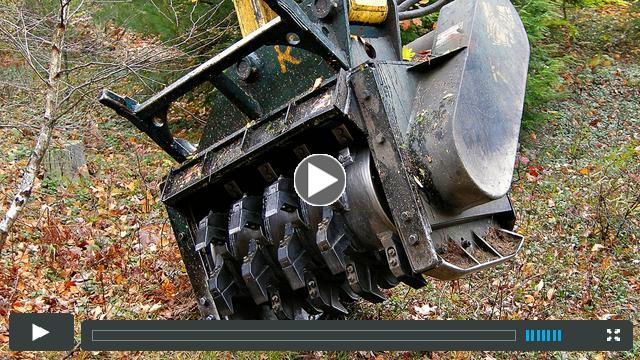|
|

A partnership of NH Fish and Game and UNH Cooperative Extension |
|
New Hampshire's Wildlife Action Plan News and Updates
|
Winter 2012
|
|
|
|
|
Visit takingactionforwildlife.org
| |
|
|
|
|
|
|
 | | A Brown Brontosaurus at work eating trees |
A Dinosaur in the Woods: How One Land Trust is Taking Action for Wildlife
This
past fall, a brontosaurus made its way through the forests of Epping
and Kingston, New Hampshire. But don't be alarmed! While this beast ate
whole trees and shrubs, leaving large forest openings in its path, it
was no dinosaur. This "brontosaurus" is actually a large flailing-head
mower attached to an excavator, used to grind up shrubs and young trees.
The machine, more commonly seen clearing power line corridors, does an
excellent job creating shrubland and young forest habitats. These large
mowers are especially useful for creating forest openings in areas where
the trees aren't large enough for a commercially viable timber harvest.
Click on the video on this page to see a brontosaurus in action! Read More
|
|
|
Wildlife Presentations Available to New Hampshire Communities
Is your community gr oup interested in hosting a presentation about New Hampshire wildlife? Does your town have a special piece of land that is under-appreciated? Volunteers from several programs are now available to present free wildlife-related programs to adult groups statewide.The Speaking for Wildlife Program, based at UNH Cooperative Extension, offers five different indoor presentations as well as a nature walk option. The Fish and Wildlife Stewards Program
is based at the New Hampshire Fish and Game Department and offers two
new talks. Both programs have trained volunteers ready to present to
community groups, libraries, town boards and other interested groups in
New Hampshire. Read More oup interested in hosting a presentation about New Hampshire wildlife? Does your town have a special piece of land that is under-appreciated? Volunteers from several programs are now available to present free wildlife-related programs to adult groups statewide.The Speaking for Wildlife Program, based at UNH Cooperative Extension, offers five different indoor presentations as well as a nature walk option. The Fish and Wildlife Stewards Program
is based at the New Hampshire Fish and Game Department and offers two
new talks. Both programs have trained volunteers ready to present to
community groups, libraries, town boards and other interested groups in
New Hampshire. Read More
|
|
Canada Lynx Documented in Northern New Hampshire!
Canada lynx are commonly f ound throughout northern Maine and Canada,
and in the past decade, roaming individuals have made their way over to
NH. This fall however, 4 Canada lynx kittens were video-taped in
Pittsburg, NH. Documentation of kittens means we may have a resident
population, not just transients, and this breeding population confirms
that NH has the habitat and prey available to support lynx. The Fish
& Game Department is now actively engaged in formal surveys for this
elusive cat. Canada lynx are a state endangered and a federally
threatened species in New Hampshire. Read More ound throughout northern Maine and Canada,
and in the past decade, roaming individuals have made their way over to
NH. This fall however, 4 Canada lynx kittens were video-taped in
Pittsburg, NH. Documentation of kittens means we may have a resident
population, not just transients, and this breeding population confirms
that NH has the habitat and prey available to support lynx. The Fish
& Game Department is now actively engaged in formal surveys for this
elusive cat. Canada lynx are a state endangered and a federally
threatened species in New Hampshire. Read More
|
 The Taking Action for
Wildlife Communities Team is working in several Carroll County and north
country towns. Currently, our work is taking us to Jefferson,
Shelburne, Sugar Hill, Ossipee, Wolfeboro, Moultonboro and Effingham.
These towns are working to incorporate information from the Wildlife
Action Plan into their natural resources inventories, develop
conservation plans for wildlife and more! To get some ideas on what your community might do, take a look at some pages on the Taking Action for Wildlife Website. On the Community Stories page,
look at examples of what other communities have done in the areas of
Natural Resources Inventories, Conservation planning for Wildlife, Land
Conservation to Protect Habitat, Using Regulation to Protect Habitat,
and Managing Habitats. Review the step-by-step instructions for each of
these topics by clicking on the links on the Communities Taking Action for Wildlife page.
Contact us if you have questions, need help or would like to apply for assistance from the Taking Action for Wildlife Team.
|
|
Newsletter Editor: Amanda Stone (UNH Cooperative Extension)
Photo Credits: Frank Mitchell (Banner photo, Bobcat), Malin Clyde (Wildlife Presentations), Amanda Stone (Winter habitat)
|
|
|
|
|
|
|
|
|